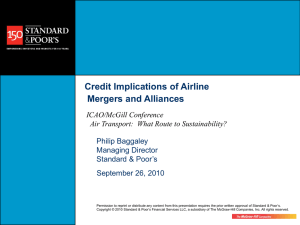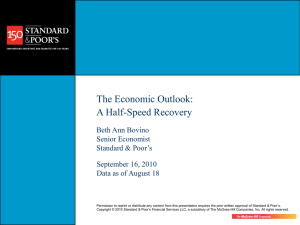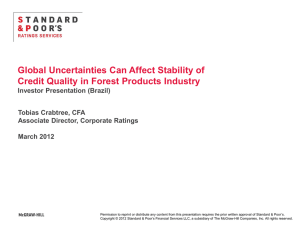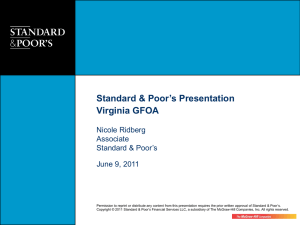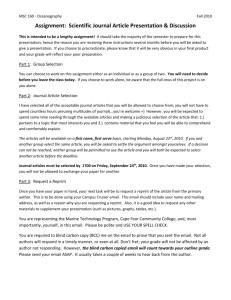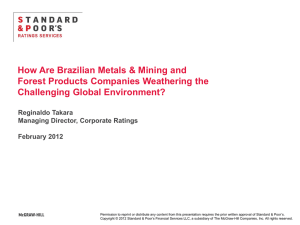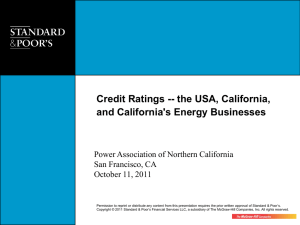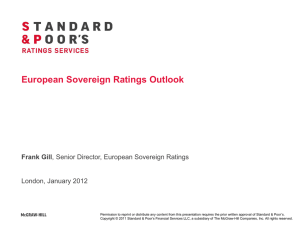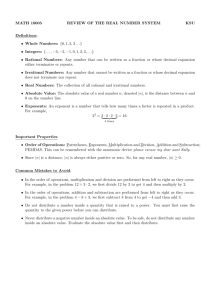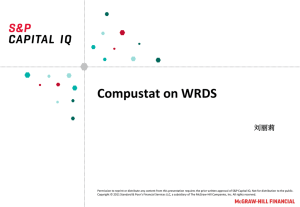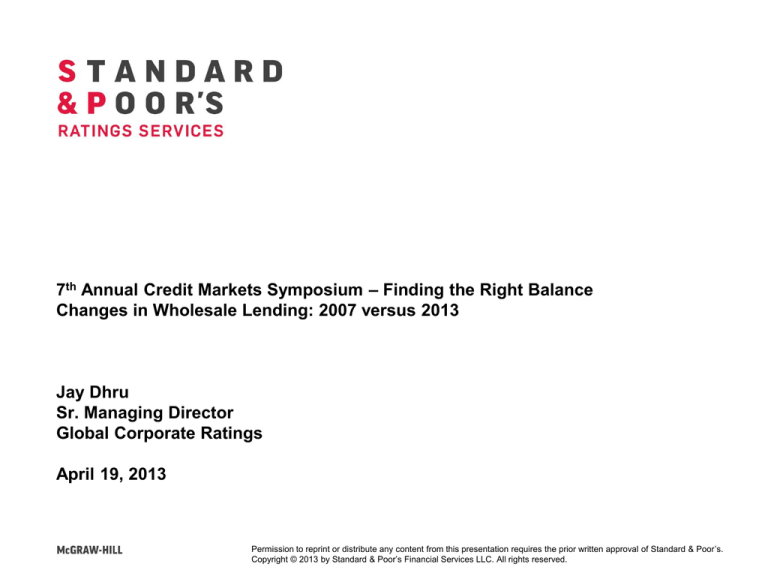
7th Annual Credit Markets Symposium – Finding the Right Balance
Changes in Wholesale Lending: 2007 versus 2013
Jay Dhru
Sr. Managing Director
Global Corporate Ratings
April 19, 2013
Permission to reprint or distribute any content from this presentation requires the prior written approval of Standard & Poor’s.
Copyright © 2013 by Standard & Poor’s Financial Services LLC. All rights reserved.
Market Conditions for U.S. Corporate Ratings
Positive Factors:
Risks and Challenges:
• Investor “thirst for yield” & low interest
rates are spurring corporate borrowing,
• Low U.S. consumer confidence is undermining
hiring and slowing economic growth - we place
the likelihood of a recession at 15% to 20%,
• Low yields on treasuries and stock market
uncertainty make corporate bonds & loans
relatively attractive,
• High yield market continues to be
receptive to new issuance in 2012),
• Barring major economic setbacks, we
expect a continuation of strong high yield
issuance in 2013,
• Corporate balance sheets and liquidity
have improved markedly since the crisis,
• Corporate profit margins and productivity
have recovered but further gains will be
challenging in a low growth environment,
• Default rates remain at low levels although
trending up marginally, and
• Fed implements third phase of
Quantitative Easing
• High structural unemployment and
underemployment are also weakening demand,
• European recession combined with a
sovereign debt crisis and decelerating growth
from China, all contribute to stronger head
winds on U.S. & global GDP growth prospects,
• Corporate earnings: Is there a potential for a
material margin squeeze given decreasing
economic and revenue growth prospects?
• Risks from automatic budget cuts (Fiscal Cliff)
and 2013 fiscal austerity,
• Effect of rising dollar on export competiveness,
• Negative effect from volatile commodity prices,
• Dodd-Frank Wall Street Reform & Consumer
Protection Act, and
• Resurgence of more liberal credit standards
(i.e. ‘covenant light’) which could have adverse
implications in the future
Permission to reprint or distribute any content from this presentation requires the prior written approval of Standard & Poor’s.
2.
United States – Annual Upgrades and Downgrades Since 2009
Upgrades
Investment Grade
Downgrades
Downgrade : Upgrade Ratio
67
67
3.02 x
49
88
1.04x
1.07x
0.96x
2010
2011
YTD 2012
47
70
72
2009
130
2009
2010
2011
YTD 2012
Downgrade : Upgrade Ratio
327
3.03 x
280
232
183
1.34x*
0.62x
204
240
0.86x
245
2009
2010
2011
*Note: 2.06x during last 6 months
Speculative Grade
704
IG and SG Upgrades and Downgrades: US Corporates, excluding Financial and Insurance
Includes downgrades to default and includes upgrades from default
Source: Global Ratings Reporting Group using QDA. Report Creation Date : 11/16/2012.
Permission to reprint or distribute any content from this presentation requires the prior written approval of Standard & Poor’s.
3.
YTD 2012
Record Amount of Cash Hoarded on Balance Sheets
• Fed Reserve Report: $1.82T of non-financial corporate cash at YE‘12
• ~5.5% increase from 2011; 12%+ increase from 2006
• ~28% increase from Great Recession in 2008
• S&P Rated: ~$1.27T of cash held by non-financial corporate issuers at YE’12
• Ratio of Cash to Total Assets is higher than historical levels
• Near 7% range from 2006 – 2008
• Peaked at over 9% in 2010 but remains elevated
S&P Rated
Federal Reserve
Permission to reprint or distribute any content from this presentation requires the prior written approval of Standard & Poor’s.
4.
Cash Not Evenly Distributed Among Ratings
• Greater Growth Among Investment Grade
• ~9% CAGR from 2006 – 2012
• Consistent Cash Flow through recession and higher offshore cash
• ‘A’ rated category and above (10% of issues) 60% of $1.27 Trillion
• Spec Grade Growth Is Lagging
• ~2.5% CAGR from 2006 – 2012
• Greater revenue declines and lower CFO generation through recession
• Higher domestic cash balance which can be distributed to sponsors & shareholders
• Held for liquidity concerns; Maturities concentrated at “B” and lower ratings.
• “B” rated category and below (46% of issues) only 10.5% of $1.27 Trillion
~9%
CAGR
~2.5%
CAGR
2012 (E)
Permission to reprint or distribute any content from this presentation requires the prior written approval of Standard & Poor’s.
5.
Cash Not Evenly Distributed Among All Rated Issuers
• Top 25 Largest Cash Holders account for 40% of Cash
• 1.5% of Total Rated Corporate Issuers
• Top 50 Account for about 52% of Total Pie, out of 1700 issuers.
2012
Top 10 Rated Issuers
• Microsoft
• Google
• Cisco
• Oracle
• Pfizer
• GM
• Ford
• Amgen
• Chevron
• J&J
$68.1B
$48.1B
$46.4B
$33.7B
$32.7B
$26.1B
$24.4B
$24.1B
$21.9B
$21.1B
Permission to reprint or distribute any content from this presentation requires the prior written approval of Standard & Poor’s.
6.
Cash Not Evenly Distributed Among All Industries
• Two Industries Hold Nearly 45% Of The Cash
1. Technology accounts for about 28% (over $350B)
Greater exposure to non-US earnings
Treasurers’ reticence to repatriate overseas cash
2. Health Care at 15% (nearly $200B)
• Improvement in Auto Sector Fundamentals Supports 7% Share of Cash
2012
2012
Permission to reprint or distribute any content from this presentation requires the prior written approval of Standard & Poor’s.
7.
How Did The Cash Balance Grow?
• Under Investment by $175B Since The Recession
• Capex fell 21% through the Recession; Revenue declined 13%
• Capex declines in 2009 and 2010 outpaced those of revenue declines
• Capex spend as a % of revenues fell from 7.5% to 6.6% from 2008 to 2010
• Capex growth did not exceed revenue growth until 2011
• Capex % spend finally returned to 2008 level in 2012
7.6
12% Decline
YE’12 (E)
Permission to reprint or distribute any content from this presentation requires the prior written approval of Standard & Poor’s.
8.
Capex Decline More Pronounced in Spec Grade
• Spec Grade Issuers underinvested about 20% of normal Capex
• Some rebound of late, but still not fully recovered
• Investment Grade Issuers underinvested by only 4%
7.6 7.6
2012 (E)
Permission to reprint or distribute any content from this presentation requires the prior written approval of Standard & Poor’s.
9.
Europe – More Caution, More Cash Pressure, Investing Elsewhere
Europe Debt 1000 –Operating Cash
Growth
Europe Debt 1000 - Cash & ST investments
(Real terms)
(Nominal)
Cash & equivalents and short-term investments, inflation-adjusted present value
Euros, Billion
1100
1000
900
Cash from operations - annual growth (%)
Year-on-year (%)
European nonfinancial companies
have a Trillion Euro
cash pile...
...but downward
pressure on
operating cash flow
15
10
800
5
700
0
600
-5
500
-10
400
2001 2002 2003 2004 2005 2006 2007 2008 2009 2010
2011
Cash Balances By European Industry
Cash & ST Investments, LTM
Avg, 2001-2011
Industries with cash
may not spend it
given long lead times
for investment and
overcapacity...
U
Ca t ilit
pi ies
ta
Tr l Gd
an s
sp
or
Au t
to
En s
M ergy
at
e
Te rials
lec
om
s
Fo F
od BT
Re
Te P t ail
ch ha
Ha rm
rd a
w
Co are
ns
Co Du
ns r
Sv
c
M s
Co
ed
m
ia
m
& Sem
Pr
of is
S
So vcs
ft w
He R ar
e e
Hh alt h t ail
ld car ing
& eE
Pe q
rs pt
Pr
od
s
Euros, Billion
160
140
120
100
80
60
40
20
0
2002
LTM
2003
2004
2005
2006
2007
2009
2010
2011
LTM
Proportion of Capex Spent Outside Europe
Proportion of capital expenditure spent outside of Europe (%)
Share of total capex
(%)
45%
...and a large and
rising share of capex
40%
is spent outside of
40%
Europe
36%
36%
42%
35%
30%
28%
25%
20%
2008
2009
2010
Source: S&P Capital IQ, S&P Ratings calculations. All data refer to a bespoke index, Europe Debt 1000. The index represents the largest 1000
companies in Europe (both publically-listed and private companies with public debt) in terms of total debt and is rebalance annually.
Permission to reprint or distribute any content from this presentation requires the prior written approval of Standard & Poor’s.
10.
2008
2011
LTM
Asia-Pacific: Cash Balances Ease As Concerns Fall
• Cash balances as percentage of assets for rated corporates in
Asia-Pacific:
– Increased to conservative levels after the global financial crisis broke.
– But eased over the past two years as liquidity concerns dissipate.
© Standard & Poor’s. 2012e is a sample estimate, actual figures may differ.
Permission to reprint or distribute any content from this presentation requires the prior written approval of Standard & Poor’s.
11.
Underinvestment Led To Higher Cash Balances…BUT
It preserved liquidity only in the short term
It artificially inflated overall corporate liquidity
Exposes competitive disadvantage
•
•
•
•
Product innovation
Manufacturing
Operating equipment maintenance
Technology
Will shrink profitability
Diminish ability to borrow
Impact credit quality
Permission to reprint or distribute any content from this presentation requires the prior written approval of Standard & Poor’s.
12.
Is The Cash Burning a Hole in Corporate Pockets?
• M&A is on the rise
• Share buy backs on the rise
• Little cost cutting left
You cannot grow by shrinking
Permission to reprint or distribute any content from this presentation requires the prior written approval of Standard & Poor’s.
13.
www.standardandpoors.com
Copyright © 2013 by Standard & Poor’s Financial Services LLC. All rights reserved.
No content (including ratings, credit-related analyses and data, valuations, model, software or other application or output therefrom) or any part thereof (Content) may be modified, reverse engineered,
reproduced or distributed in any form by any means, or stored in a database or retrieval system, without the prior written permission of Standard & Poor’s Financial Services LLC or its affiliates (collectively,
S&P). The Content shall not be used for any unlawful or unauthorized purposes. S&P and any third-party providers, as well as their directors, officers, shareholders, employees or agents (collectively S&P
Parties) do not guarantee the accuracy, completeness, timeliness or availability of the Content. S&P Parties are not responsible for any errors or omissions (negligent or otherwise), regardless of the cause,
for the results obtained from the use of the Content, or for the security or maintenance of any data input by the user. The Content is provided on an “as is” basis. S&P PARTIES DISCLAIM ANY AND ALL
EXPRESS OR IMPLIED WARRANTIES, INCLUDING, BUT NOT LIMITED TO, ANY WARRANTIES OF MERCHANTABILITY OR FITNESS FOR A PARTICULAR PURPOSE OR USE, FREEDOM FROM
BUGS, SOFTWARE ERRORS OR DEFECTS, THAT THE CONTENT’S FUNCTIONING WILL BE UNINTERRUPTED OR THAT THE CONTENT WILL OPERATE WITH ANY SOFTWARE OR HARDWARE
CONFIGURATION. In no event shall S&P Parties be liable to any party for any direct, indirect, incidental, exemplary, compensatory, punitive, special or consequential damages, costs, expenses, legal fees,
or losses (including, without limitation, lost income or lost profits and opportunity costs or losses caused by negligence) in connection with any use of the Content even if advised of the possibility of such
damages.
Credit-related and other analyses, including ratings, and statements in the Content are statements of opinion as of the date they are expressed and not statements of fact. S&P’s opinions, analyses and
rating acknowledgment decisions (described below) are not recommendations to purchase, hold, or sell any securities or to make any investment decisions, and do not address the suitability of any security.
S&P assumes no obligation to update the Content following publication in any form or format. The Content should not be relied on and is not a substitute for the skill, judgment and experience of the user, its
management, employees, advisors and/or clients when making investment and other business decisions. S&P does not act as a fiduciary or an investment advisor except where registered as such. While
S&P has obtained information from sources it believes to be reliable, S&P does not perform an audit and undertakes no duty of due diligence or independent verification of any information it receives.
To the extent that regulatory authorities allow a rating agency to acknowledge in one jurisdiction a rating issued in another jurisdiction for certain regulatory purposes, S&P reserves the right to assign,
withdraw or suspend such acknowledgement at any time and in its sole discretion. S&P Parties disclaim any duty whatsoever arising out of the assignment, withdrawal or suspension of an acknowledgment
as well as any liability for any damage alleged to have been suffered on account thereof.
S&P keeps certain activities of its business units separate from each other in order to preserve the independence and objectivity of their respective activities. As a result, certain business units of S&P may
have information that is not available to other S&P business units. S&P has established policies and procedures to maintain the confidentiality of certain non-public information received in connection with
each analytical process.
S&P may receive compensation for its ratings and certain analyses, normally from issuers or underwriters of securities or from obligors. S&P reserves the right to disseminate its opinions and analyses.
S&P's public ratings and analyses are made available on its Web sites, www.standardandpoors.com (free of charge), and www.ratingsdirect.com and www.globalcreditportal.com (subscription), and may be
distributed through other means, including via S&P publications and third-party redistributors. Additional information about our ratings fees is available at www.standardandpoors.com/usratingsfees.
Permission to reprint or distribute any content from this presentation requires the prior written approval of Standard & Poor’s.
14.
STANDARD & POOR’S, S&P, GLOBAL CREDIT PORTAL and RATINGSDIRECT are registered trademarks of Standard & Poor’s Financial Services LLC.


